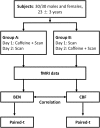Caffeine Caused a Widespread Increase of Resting Brain Entropy
- PMID: 29426918
- PMCID: PMC5807546
- DOI: 10.1038/s41598-018-21008-6
Caffeine Caused a Widespread Increase of Resting Brain Entropy
Abstract
Entropy is an important trait of brain function and high entropy indicates high information processing capacity. We recently demonstrated that brain entropy (BEN) is stable across time and differs between controls and patients with various brain disorders. The purpose of this study was to examine whether BEN is sensitive to pharmaceutical modulations with caffeine. Both cerebral blood flow (CBF) and resting fMRI were collected from sixty caffeine-naïve healthy subjects before and after taking a 200 mg caffeine pill. Our data showed that caffeine reduced CBF in the whole brain but increased BEN across the cerebral cortex with the highest increase in lateral prefrontal cortex, the default mode network (DMN), visual cortex, and motor network, consistent with the beneficial effects of caffeine (such as vigilance and attention) on these areas. BEN increase was correlated to CBF reduction only in several regions (-0.5 < r < -0.4), indicating a neuronal nature for most of the observed BEN alterations. In summary, we showed the first evidence of BEN alterations due to caffeine ingestion, suggesting BEN as a biomarker sensitive to pharmaceutical brain function modulations.
Conflict of interest statement
The authors declare no competing interests.
Figures




References
-
- Friston KJ, Tononi G, Sporns O, Edelman GM. Characterising the complexity of neuronal interactions. Hum Brain Mapp. 1995;3:302–314. doi: 10.1002/hbm.460030405. - DOI
Publication types
MeSH terms
Substances
LinkOut - more resources
Full Text Sources
Other Literature Sources
Medical

